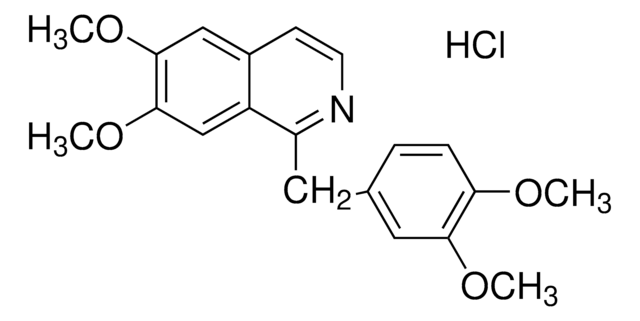おすすめの製品
フォーム
solid
色
white
溶解性
45% (w/v) aq 2-hydroxypropyl-β-cyclodextrin: >10 mg/mL
H2O: 10 mg/mL
methanol: 28 mg/mL
SMILES記法
[Na+].CCCCCN(CCCCC)C(=O)C(CCC([O-])=O)NC(=O)c1ccc(Cl)c(Cl)c1
InChI
1S/C22H32Cl2N2O4.Na/c1-3-5-7-13-26(14-8-6-4-2)22(30)19(11-12-20(27)28)25-21(29)16-9-10-17(23)18(24)15-16;/h9-10,15,19H,3-8,11-14H2,1-2H3,(H,25,29)(H,27,28);/q;+1/p-1
InChI Key
JCNPYMDDOUQTBK-UHFFFAOYSA-M
遺伝子情報
human ... CCKAR(886)
アプリケーション
Lorglumide sodium salt has been used as a cck-a (cholecystokinin A) receptor antagonist for peptide determination in rat islet cells. It has been used as a CCK1 inhibitor to check the effect of cck1 (cck-a) and cck2 (cck-b) receptors on cerulein-induced upregulation of egr-1 (early growth response 1) expression in rat pancreatic acinar cells.
生物化学的/生理学的作用
コレシストキニン(CCKA)レセプタ-の強力かつ選択的な非ペプチド性アンタゴニストです。経口活性があります。
保管分類コード
11 - Combustible Solids
WGK
WGK 2
引火点(°F)
Not applicable
引火点(℃)
Not applicable
個人用保護具 (PPE)
Eyeshields, Gloves, type N95 (US)
適用法令
試験研究用途を考慮した関連法令を主に挙げております。化学物質以外については、一部の情報のみ提供しています。 製品を安全かつ合法的に使用することは、使用者の義務です。最新情報により修正される場合があります。WEBの反映には時間を要することがあるため、適宜SDSをご参照ください。
Jan Code
L109-250MG:
L109-50MG:
L109-BULK:
L109-VAR:
F Makovec et al.
Arzneimittel-Forschung, 37(11), 1265-1268 (1987-11-01)
Derivatives of 5-(dipentylamino)-5-oxo-pentanoic acid are a new class of non-peptide cholecystokinin (CCK) antagonists. The most potent compound, D,L-4-(3,4-dichlorobenzoylamino)-5-(dipentylamino)-5-oxo-pen tanoic acid (lorglumide, CR 1409), has a great affinity for the pancreatic CCK receptors and is a competitive, specific and potent CCK
M D'Amato et al.
British journal of pharmacology, 102(2), 391-395 (1991-02-01)
1. Three recently described non-peptide cholecystokinin (CCK) antagonists (devazepide, lorglumide, loxiglumide) have been studied for their antagonism of the contraction to cholecystokinin-octapeptide (CCK-OP) in human alimentary muscle and guinea-pig intestine. 2. Each antagonist caused a concentration-dependent inhibition of the contraction
Yukio Ikeda et al.
Biochemical and biophysical research communications, 333(3), 778-786 (2005-06-22)
The glucose-induced insulin secretion is fine-tuned by numerous factors. To systematically identify insulinotropic factors, we optimized a primary beta-cell-based functional assay to monitor intracellular Ca2+ flux ([Ca2+]i). By this assay system, we successfully identified several insulinotropic peptides including cholecystokinin, gastrin
H W Suh et al.
Peptides, 16(7), 1229-1234 (1995-01-01)
Various doses of sulfated cholecystokinin octapeptide (CCK-8s) injected intracerebroventricularly (ICV) alone did not show any antinociceptive effect. CCK-8s (0.01-1 ng) pretreated ICV for 10 min dose-dependently attenuated the inhibition of the tail flick response induced by ICV-administered morphine (2 micrograms).
G L Edwards et al.
Annals of the New York Academy of Sciences, 897, 192-197 (2000-02-17)
Ingestion of food and fluid stimulates release of a number of peptides from the gastrointestinal system. These peptides are recognized to act as neurotransmitters/neuromodulators and act at both peripheral and central receptors. Many studies indicate that these peptides are important
ライフサイエンス、有機合成、材料科学、クロマトグラフィー、分析など、あらゆる分野の研究に経験のあるメンバーがおります。.
製品に関するお問い合わせはこちら(テクニカルサービス)![(Tyr[SO3H]27)コレシストキニンフラグメント 26-33 アミド ≥97% (HPLC), powder](/deepweb/assets/sigmaaldrich/product/structures/125/021/32eb71ec-73e5-4cfc-94d0-ebcf5e784e39/640/32eb71ec-73e5-4cfc-94d0-ebcf5e784e39.png)








